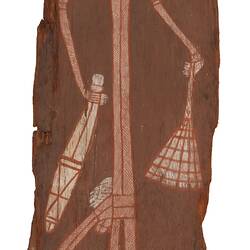Summary
Museums Victoria holds significant collections of artworks by Australian Aboriginal artists dating from the nineteenth and early twentieth centuries. This painting is amongst the earliest works collected by the director of the National Museum of Victoria, Walter Baldwin Spencer, who went to Oenpelli in 1912. Oenpelli was a pastoral lease taken up in 1906 by the legendary Northern Territory figure Paddy Cahill. Spencer returned to Melbourne with thirty-eight works on bark that had been removed from the wet season shelters in the area of the East and South Alligator Rivers. The collaboration between these two men over the following decade would result in the commissioning of over 170 bark paintings for the museum. The imagery in the works derive from a vast array of animals that are depicted in the rich rock art of the region, as well as a significant number of spirit figures known to bining, the people of western Arnhem Land. The bark paintings in the Spencer Collection and the Paddy Cahill Collection are considered the most significant historical art works from western Arnhem Land, and often feature in national and international exhibitions and publications. These paintings take pride of place amongst the extensive and significant holdings of Aboriginal art in the Indigenous collections at Museums Victoria. The only earlier known bark paintings are in the Macleay Museum in Sydney and date from 1878 and were collected at Port Essington.
Physical Description
A single sheet of eucalyptus bark, stringybark (Eucalyptus tetrodonta), painted with natural pigments. The image of a single male spirit figure.
Significance
This spirit figure lives amongst the caves and is associated with Gaagudju people of western Arnhem Land. Baldwin Spencer identified the figure as 'Numereji' noting that 'medicine men see him, talk to him'.The depiction here is a front view of the figure and has the typical prominent and distinctive head, face and hair that distinguishes this particular spirit figure. Typically these also are shown with additional and exaggerated digits on their hands and feet, and this one has extra toes on both feet and extra fingers. The figure has a club in its right hand that is painted with the distinctive geometric patterning found on men's clubs from this region. This, Spencer noted, allowed him to 'fight off hostile spirits from adjoining regions', while the bunch of feathers in the left hand were used when dancing. Spencer further noted that this spirit visits graves and presses down with both hands on the deceased and shaking him to get up. Other spirits then come and perform a ceremony.
More Information
-
Object/Medium
Painting, bark
-
Maker
-
Cultural Groups
-
Locality
Oenpelli, Western Arnhem Land, Northern Territory, Australia
-
Date Produced
-
Collector
-
Date Collected
-
Object Measurements
1500 mm (Length), 610 mm (Width), 70 mm (Height)
-
Keywords
-
References
[Book] Museum Victoria. 2004. Treasures of the Museum. Victoria, Australia. 206.
-
Collection Names
-
Type of item
-
Discipline
-
Category
-
Collecting Areas
Australian Indigenous - Northern Australia and Queensland and Torres Strait Islands
-
Medium
Natural pigments
-
Technique
Painting
-
Support
Eucalyptus bark



